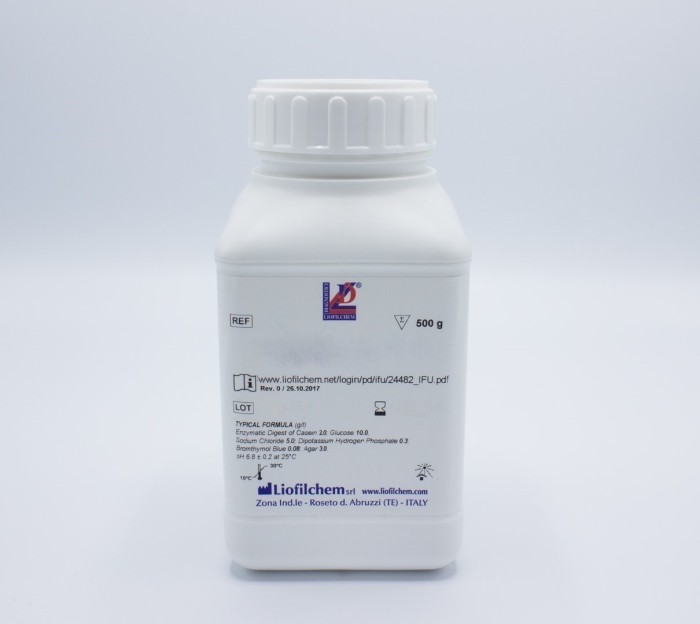Liofilchem™ Sulphur, Indole, Motility - SIM Medium (Dehydrated)
Catalog No :
CAS Number :
Brand :
In Stock
Differentiate enteric bacteria on the basis of sulfide production, indole production, and motility
Specifications:
| Application | Microbiology | ||
| Storage Temperature | Room Temperature | ||
| Product Type | Culture Medium | Forms | Powder |
| Product Brand | Liofilchem | ||
| Product Grade | Microbiology grade | ||
Semisolid Differential Medium for Detection of Sulfide, Indole, and Motility Activity in Enterobacteriaceae
SIM Medium (Sulfide, Indole, Motility Medium) by Liofilchem® is a semisolid culture medium formulated for the biochemical differentiation of Enterobacteriaceae and other gram-negative bacteria. It allows simultaneous testing of:
- Hydrogen sulfide (H₂S) production
- Indole formation from tryptophan
- Bacterial motility
SIM Medium serves as a key diagnostic aid for species-level identification and distinction within the Proteus, Salmonella, Shigella, Klebsiella, and Escherichia groups, among others.
Key Features & Benefits
✅ Triple Differentiation in One Tube
– Evaluates three critical microbial characteristics (sulfide, indole, motility) with a single inoculation.
✅ Semisolid Format
– Low agar concentration permits easy visualization of motility while maintaining media integrity.
✅ Reliable H₂S Detection
– Sodium thiosulphate and ferric ammonium sulfate react to produce a black precipitate when H₂S is present.
✅ Rapid Indole Testing
– Indole production is confirmed by adding Kovac’s Reagent after incubation, yielding a distinct red/pink color in positive cases.
✅ Standardized Performance
– Optimized formula and quality control ensure reproducible diagnostic outcomes, ideal for clinical and research microbiology.
Applications
- Clinical bacteriology for presumptive identification of enteric pathogens
- Food and environmental microbiology
- Pharmaceutical microbial testing
- Educational demonstrations in microbiology
Test Principle
- Peptones provide essential nutrients and tryptophan for indole production.
- Sodium thiosulphate and ferric ammonium sulfate detect H₂S via formation of ferrous sulfide (black precipitate).
- Semisolid agar (3.5 g/L) allows differentiation of motile vs non-motile organisms based on spreading growth.
Preparation & Usage
- Suspend 30 g of powder in 1 L of distilled water. Boil to dissolve.
- Dispense into test tubes to a depth of approximately 4 cm.
- Sterilize by autoclaving at 121°C for 15 minutes.
- Inoculate tubes with a straight stab using fresh culture.
- Incubate at 35 ± 2°C for 18–24 hours with loose caps.
- Evaluate for motility, H₂S, and add Kovac’s Reagent (Ref. 87001) for indole detection.
Interpretation of Results
| Parameter | Positive Reaction | Negative Reaction |
|---|---|---|
| Motility | Diffuse or hazy growth away from stab line | Growth restricted to stab line |
| H₂S | Blackening along stab or medium | No blackening |
| Indole | Pink or red layer after Kovac's | No color change |
Typical Microbial Reactions
| Organism | Sulphide | Indole | Motility |
|---|---|---|---|
| Escherichia coli | − | + | + |
| Salmonella Typhimurium | + | − | + |
| Shigella flexneri | − | − | − |
| Proteus vulgaris | + | + | + |
| Klebsiella pneumoniae | − | + | − |
| Enterobacter spp. | − | − | + |
Note: Yersinia enterocolitica is motile at 25°C but not at 37°C.
Specifications
| Property | Description |
|---|---|
| Format | Tubes, Bottles, or Dehydrated Powder |
| Dehydrated Media | 30 g/L |
| Final pH | 7.3 ± 0.2 at 25°C |
| Color (prepared) | Amber, semisolid, slightly opalescent |
| Storage | 10–30°C (powder), 10–25°C (tubes/bottles) |
| Shelf Life | 4 years (powder), 1–2 years (tubes/bottles) |
Ordering Information
| Product | Format | Packaging | Ref. |
|---|---|---|---|
| SIM Medium | Tube | 20 × 9 mL | 24479 |
| SIM Medium | Tube | 100 × 10 mL | 26095 |
| SIM Medium | Bottle | 6 × 100 mL | 403050 |
| SIM Medium | Dehydrated Powder | 500 g | 610181 |
| SIM Medium | Dehydrated Powder | 100 g | 620181 |
The Liofilchem® SIM Medium provides a robust, three-in-one solution for evaluating the biochemical characteristics of gram-negative bacteria. Its design simplifies workflows while supporting accurate differentiation critical to diagnostic microbiology.




 0
0
